The dynamics of the automotive market has imposed that models are updated in moderately short periods of time and the Japanese firm based in Hiroshima is no exception. Mazda CX-5 is a product in constant evolution. The model analyzed corresponds to a restyling of 2015 on the original model of 2012, with few visual changes and yes some other correction and correction of problems.
For this test we have chosen a route of approximately 380 km, with little highway, a lot of national road, several mountain passes and a few kilometers of dirt track in good condition and with few potholes. The idea was to reflect the typical weekend "getaway" that the owner of this type of car usually makes. In addition to this trip we have done another 360 km through the city and surrounding roads, with little traffic because in August the cities in the center of the peninsula are usually empty, making it a pleasant space where you can enjoy driving.
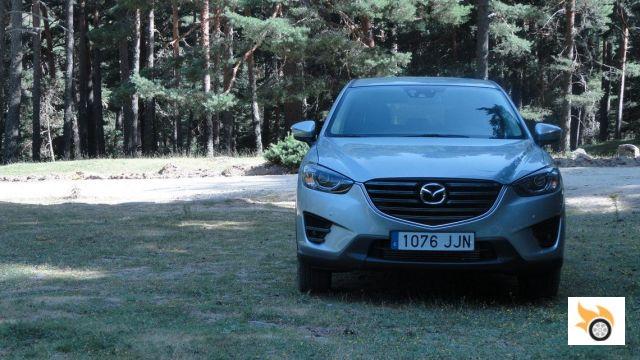
Design
Before going to point out changes and specific aspects of the car, I want to move the first overall impression offered by the Mazda CX-5. Regarding the exterior shapes, there are areas that are reminiscent of solutions from other manufacturers. This is because there are trends that the industry follows, as in fashion in clothing; when "skinny" trousers are in fashion, it is difficult to find straight cut trousers. It is not a question of copying each other, which is also true, but rather that certain ways of doing things are imposed. In this sense, the body of the Mazda CX-5 is not particularly original, although its overall aesthetics are pleasing.
The Mazda CX-5 is a car that is designed and built with care.
The feeling of being in a "more of the same" begins to fade as you enter the interior and look around. Aside from the pleasant sound of the door closing, which denotes good workmanship, the details start to come to the forefront of your senses. You can tell the Mazda CX-5 is a car designed and built with care. It's not just about the quality of the finish; at the price level that this car moves, the value, like the soldier, is assumed. I'm talking about details, small subtleties that have probably taken a few hours of thought. I am reminded of the impression I had when I opened the glove compartment and found a superb 3.4 cm thick user manual, perfectly structured and bound, together with two other smaller ones. Or the design of the holes to contain bottles, which have a lateral adjustment mechanism by spring, so that the object contained does not move or vibrate while driving, in addition to providing sponges to reduce the depth of the hole in the case of small bottles. Beyond these touches to detail, the layout of all the controls and control elements is well thought out (and better arranged than in the original model) in addition to having taken care of the accessibility to operate them without taking your eyes off the road in most cases, highlighting the ease of learning and use.
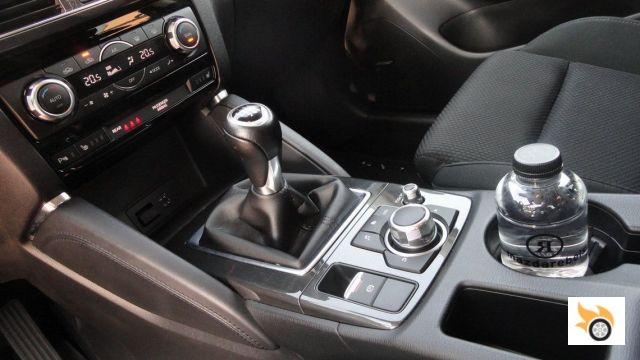
Now let's get more specific. The 2015 update has a special weight on the front of the model. The primitive front grille had a certain radiator feel to it with its grilles arranged like a honeycomb, offering a somewhat raw, unfinished look. With last year's evolution, this element now has five horizontal slats, where the top three are now divided around the brand logo, which is visually more integrated. The new front and rear light clusters are LED and vary depending on the trim level, and are available from the Style+ trim level upwards. The base model is equipped with halogen headlamps and fog lamps are standard across the range (LED on higher trim levels).
Another visually striking element are the new 19-inch wheels with two-tone diamond-cut finish. This design is also present on the 17-inch wheels. It is added to the 2015 range, as a novelty, a new body tone: Sonic Silver and Titanium Flash, present in other products of the brand, joins the CX-5 family. The shape of the exterior mirrors has been modified to reduce aerodynamic noise, and integrate the side indicator.
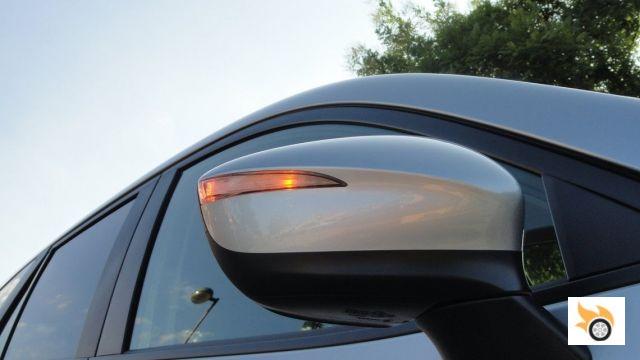
The interior of the Mazda CX-5 2015 also incorporates new features, among which are particularly noteworthy: the new top screen (larger and wider), the presence of the MZD Connect system and the removal of the conventional handbrake in favor of an electric parking brake (not present in the base model). The removal of the handbrake lever and the more forward position of the display controls results in a more uncluttered design and has allowed the addition of a second central cup holder. The electric handbrake does its job well. It has an automatic function if the seat belts are fastened and in the event of unintentional activation while driving - it's just another button - it disengages immediately. We tested this feature and the impact on the car's handling was practically nil, only slowing the car down slightly for a moment.
The seats in the 2015 Mazda CX-5 have also evolved for the better. The front ones have better support, comfort is better overall and are offered, as a novelty, with a white leather upholstery if desired (in black also exists and both are optional). The test model, with Luxury trim level, has cloth upholstery that exudes quality and looks nice.
As a summary of this section, the Mazda CX-5 evolved is a car that visually does not go unnoticed. The clean and simple lines do not detract from its presence, and if you take a look at the interior it does not disappoint, it is in harmony with the exterior. This consideration, together with those small details that make the difference and are so nice, give it the score of "high notable" that you can see at the end of the test.
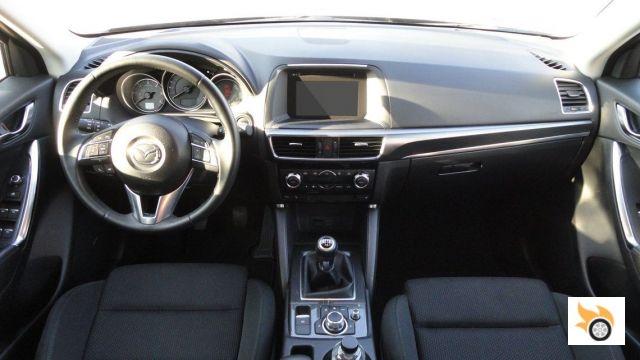
Cabin
As you would expect from a car of this size, which is also well designed, the cabin of the Mazda CX-5 is spacious and generous. Of the five seats that homologates the car, four of them are really comfortable, admitting without difficulty to tall and strong people. Adjusting the driver's seat to my height (1.70 m), when I sat in the twin rear seat, my knees were separated from the front seat about 20 cm. The headroom is good and perhaps the only drawback for very tall people is the maximum range to which the headrests can be raised. The fifth seat can be used for a child seat, a not very big child, a masochist or a fakir; it's narrow, hard and really uncomfortable. The ideal for this car are four adults, marriage with the couple, and then yes, the rear passengers can travel really comfortable, being able to extract from the central seat a practical armrest, with two holes to carry bottles. The 463-litre boot is enough luggage for all the passengers in the Mazda CX-5. The rear seats can be folded down in a 40/20/40 layout, leaving an almost flat surface. The engineers responsible for the model have made good use of the space to include various storage elements and recesses everywhere. The glove box is deep and generously proportioned.
Another aspect to consider is the sound insulation of the Mazda CX-5, which has improved, according to the manufacturer, up to 13% in the redesign of 2015. The truth is that in running order the engine noise is almost just enough to know it's there, and those due to rolling and aerodynamics are more than acceptable. At 120 km / h the interior noise level passes into the background if there is a conversation or listening to a melody.
For all the above considerations, the score in the "habitability" section is compromised, according to the formula we used, by the central rear seat, which is not up to the level of the others. As for the "comfort" section, the headrests' somewhat short travel for tall people slightly penalises the score.
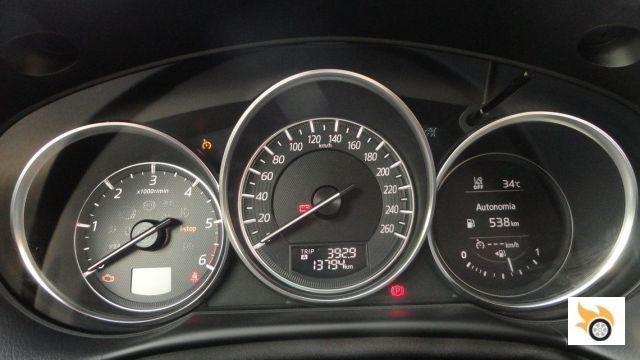
Having analysed the container, let's take a closer look at its contents. We start with the driving position, where there are a good number of controls to handle with each hand. They are all essential to bring the car to fruition are accessible without taking your back off the seat and almost without taking your eyes off the important things. On the left front door are the controls for opening and closing the windows, locking them and controlling the rear-view mirrors. On the dashboard, the left ventilation grille is completely accessible. Below it are a number of buttons that are not so easily accessible, such as traction control, lane departure warning, blind spot monitoring, i-stop and tyre pressure monitoring. That they are not easily accessible is not a problem, on the contrary, these safety features are activated by default and their disconnection is a serious matter and should never be done while the car is in motion. The fact that they are within reach, but not in motion, is a good thing.
Behind the steering wheel there are two satellite controls: light control on the left and windscreen wipers on the right. Above the main steering wheel spokes are two groups of buttons with distinct functions: on the left are multimedia controls such as forward and reverse, speaker volume, mobile phone operation (if paired to the system via BlueTooth), and on-board computer function/screen switching. On the right spoke of the steering wheel are the controls for the cruise control. Everything is simple, well laid out and within reach of almost any type of hand, including small hands.
The main information is displayed through three circles: tachometer on the left, speedometer in the central position and on-board computer on the right. The first two are dotted with information and warning lights, although there are some outside these two enclosures. The indicator that suggests the gear change, located inside the tachometer circle and clearly visible. The button on and off the engine and other services is in a slightly lower position than the previous group, located to the right of the on-board computer.
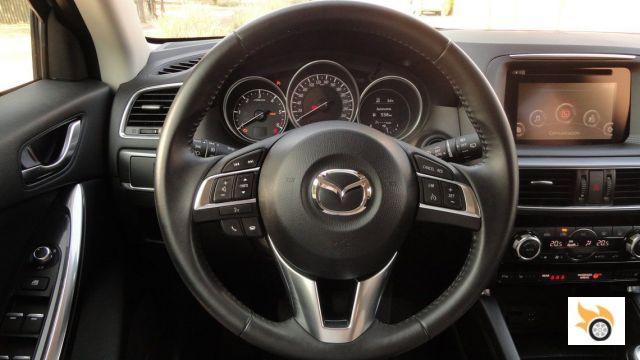
The front of the Mazda CX-5's cabin is divided into two volumes, thanks to the central area of the dashboard and a horizontal console that separates the two front seats. Above the dashboard is the large 7-inch touchscreen infotainment system, with the CD player located in the upper area. Below the screen are the two central air vents and the hazard light button. Next in descending order are the buttons and controls for the dual-zone climate control system. Below that, a group of warning lights related to the seatbelts and airbag (in case a child seat is installed), plus the odd atypical button not usually seen on "normal" models, such as seat heating or a button to reset the navigation system if the screen is otherwise occupied.
When the center console leaves the vertical part, it transforms into a wide and deep recess that can be used as an eventual small object holder (such as a wallet to have cash ready or a credit card to pay a toll), although the ideal is to place the smartphone there, since the two USB and auxiliary sockets are placed at the bottom of that enclosure. After the previous recess is the gear selector (manual or automatic), after this the central wheel that acts as a cursor and touchscreen selector, another smaller one for volume control (which also turns on and off the infotainment system), other controls related to this system (home, reverse, music, browser and favorites), and to the left of this group the electric handbrake button.
It seems like a lot of controls, systems and information, and indeed it is, but so well arranged and designed to make life easier for the driver, that you get used to it in a short time and with a very benevolent learning curve.
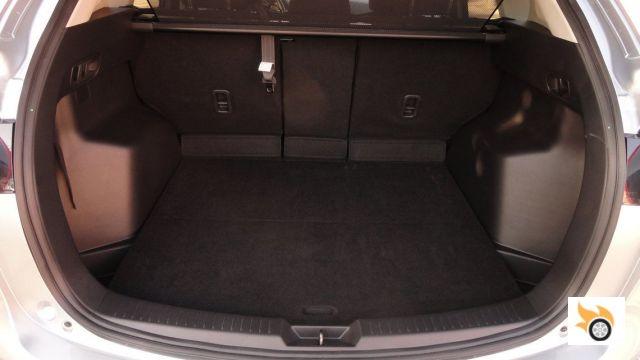
The infotainment chapter usually deserves separate attention, but in the Mazda CX-5 especially because of how comprehensive and useful it is, as well as its quality. Mazda has named the system MZD Connect. The test unit, as usual, is equipped with the best of the house, starting with the sound system, equipped with nine speakers and digital amplifier signed by BOSE (Luxury trim level), with signature technologies such as surround called Certerpoint, or noise compensation Surround Stage AudioPilot 2, in addition to having eight channels of custom equalization. The sound is excellent.
The radio receiver tunes the stations well. A variety of USB-compatible devices can be connected. It plays music stored on a smartphone via BlueTooth. It has a CD player... In this respect the musical needs of any user are practically covered. MZD Connect goes one step further, offering voice recognition and hands-free operation. In conjunction with a compatible smartphone, the system allows access to the internet, social media and takes advantage of the vast capabilities of the aha® cloud-based platform, with more than 100,000 radio stations, podcasts and audiobooks, as well as personalised location-based services developed specifically for the Mazda CX-5. Among the possibilities is the ability to listen to tweets or Facebook posts, reply with a "like" or post audio messages using a voice function. The 7-inch touchscreen is also responsible for displaying the information provided by the system's applications: fuel consumption, vehicle status and maintenance schedule. The rear view camera takes over the screen as soon as the reverse gear is engaged.
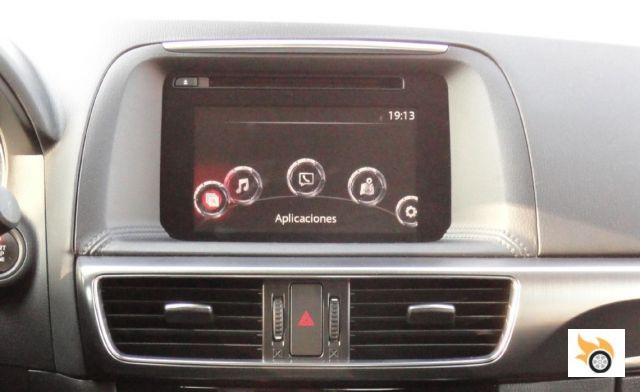
Another heavyweight of the infotainment system is the navigation system. The information is provided in color, in 2D or 3D to the consumer's taste and the quality of the screen is excellent. However, it does have some drawbacks, more or less significant. The first one, which can be rectified, is the amount of adjustments that the system configuration allows, being able to choose/suppress tolls, ferry, motorways, etc. You have to pay attention to this aspect because, depending on the configuration, the choice of route that the system makes can be surreal and you can end up driving around the Plaza de Colón, without finding the statue of D. Cristóbal. The previous sentence is an exaggeration, obviously, but I tried putting a few restrictions near my home and the turn I took to get home was significant.
The next dark spot is in the roundabouts. The system counts exits somewhat ad libitum. Sometimes it counts as exits places where you obviously can't exit (because it's a forbidden direction) and sometimes not. In a large roundabout with several accesses you can get confused, taking into account that the map rotates on the screen with a significant delay. On the other hand, the voice assistant supports a lot of information on the name of the streets or roads. This, in many places in Spain, is a problem because either the street names don't exist, or they're covered by a tree, or they're narrow, or by virtue of Murphy's Law you arrive at the intersection at an angle where it's impossible to read the sign even if Eagle Eye is in the copilot's seat. Finally, the way exits and junctions are indicated as "curves", when they are not, is also misleading. I know of affordable navigation systems on sale in large stores that don't have these problems. Anyway, you get used to this way of providing route information. Regardless of the above, the mapping of the system is excellent.
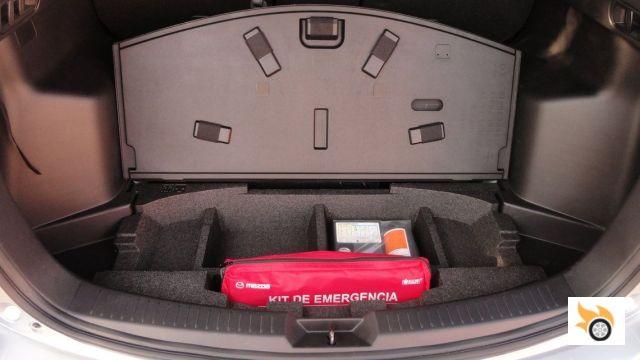
Technology
SKYACTIV is the magic word. More than just a platform or a set of technologies, it's Mazda's vision of how a car should be built with efficiency in mind. The Mazda CX-5 was the model that kicked off the SKYACTIV era when it debuted at the 2011 Frankfurt Motor Show. SKYACTIV stands for engines, transmissions, body and chassis. In terms of engines, the CX-5 family has four different powertrains, two petrol and two diesel. All are inline four-cylinder engines with dual overhead camshafts (DOHC), 16 valves and direct injection.
The smallest engine (1,998 cc) is a petrol engine and is available in two power ratings: 165 hp and 210 Nm of torque for front-wheel drive (FWD) models and 160 hp and 208 Nm of torque for those with permanent all-wheel drive (AWD). At the opposite end we find the most powerful engine (192 hp and 256 Nm of torque) and larger displacement (2,488 cc), also gasoline, which is mounted exclusively with AWD. As for the petrol engines, there are two versions of identical displacement (2,191 cc): one with 150 hp and 380 Nm of maximum torque, and the other with 175 hp and 420 Nm of torque. The former is available for both front-wheel and all-wheel drive models. The second is for AWD models only. The petrol engines are called SKYACTIV-G and the diesel engines SKYACTIV-D.
The 150 hp diesel engine is the only one exempt from registration tax.
In terms of transmission, Mazda supplies two six-speed systems: SKYACTIV-MT (manual) and SKYACTIV-DRIVE (automatic). The manual is fitted to both front- and all-wheel-drive models. The automatic is always linked to AWD. The suspensions have also undergone changes in the 2015 restyling, with new shock absorbers. The front ones are McPherson struts, and the rear ones are multi-link on all models. The same goes for the brake discs: ventilated front (297 mm in diameter), and solid rear (303 millimeters in diameter), common to all versions of the Mazda CX-5. The wheels can be 17 and 19 inches, with tire sizes ranging from 225/65 R17 for the former and 225/55 R19 for the latter.
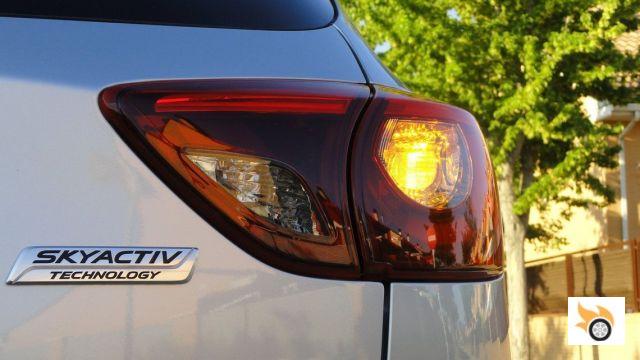
The Mazda CX-5 used in this test is powered by the 2.2L. SKYACTIV-D 150 hp, front-wheel drive, six-speed manual gearbox and Toyo 225/55 R19 tires on 19-inch alloy wheels. With this combination of features the manufacturer declares a top speed of 202 km / h with limiter. The 119 g/km CO2 emissions of this engine are exempt from registration tax. It is the only one, as the other engines exceed the limit of 120 g/km CO2 and must necessarily pass through this box.
Safety is an aspect in which the Japanese manufacturer has invested time and money. Under the name i-ACTIVSENSE a series of active safety systems based on sensors that use radar, laser and cameras to inform the driver of the environment in which it circulates are grouped. For example, adaptive and directional LED headlights, Lane Departure Warning System (LKA) and Lane Departure Warning System (LDWS), Blind Spot Monitoring, Fatigue Detection, Rear Cross Traffic Alert, Blind Spot Monitoring during reversing, Front and Rear City Brake Assist, hill start assist, automatic emergency stop signal, and other more common (and standard across the range) systems such as four-way ABS with electronic brake-force distribution (EBD) and Electronic Brake Assist (EBA), stability control (DSC) and traction control (TCS). Some of these systems have been incorporated for the first time on models sold in Europe and are dependent on trim level, although the most important are found on any CX-5 model. The active safety features of the test model are: rear cross-traffic alert, hill start assist, blind spot monitoring, city brake assist system and tire pressure warning light.
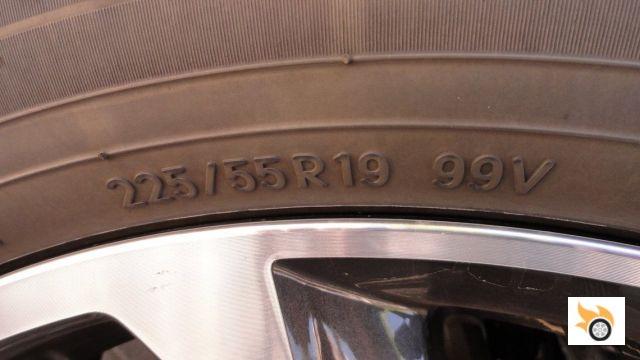
The adaptive LED headlights (ALH) and directional headlights (AFLS), in Mazda terminology, stand out. The first acronym refers to a system that combines LED high beam headlights divided into four independent blocks, dipped beam headlights with a wider range and a self-levelling function on the motorway. The aim is to avoid dazzling oncoming traffic and those in front. When the system's camera detects another vehicle, it selectively switches off the dazzling groups of LEDs, keeping the rest on.
Passive safety revolves around the SKYACTIV-Body concept, a construction technology that combines structures and materials for maximum impact energy absorption without increasing weight; strength combined with lightness. Front, side and curtain airbags are standard across the 2015 Mazda CX-5 range. The CX-5 family features ISOFIX connections and Top Tether anchorages for easy and safe installation of child seats.
Driving
When you first start the engine, the soundproofing work behind the Mazda CX-5 is immediately noticeable, particularly with the diesel powertrain. The engine noise seems to emerge from the depths of a cave. Forceful, deep and muffled, like the guttural sound of big cats. You press the clutch, insert first gear, and as you release the left pedal again, the car starts to move smoothly. All the action on levers, pedals, steering wheel and the movement of the car itself starts with the harmony of a ballet. As soon as I leave the Mazda facilities and once in the street, I pay attention to the gear shift indicator; as soon as you exceed 1,500 RPM it suggests you to use the next gear. So I do.
I land in an area practically deserted of people and traffic, with long straights, dotted every 500 meters or so by roundabouts. When the third one starts to ask for a replacement, I have to slow down again. Roundabout in sight. Back to the start. I have this same scenario ahead of me for at least 2.5 km. In the first stretch where the distance between roundabouts is a bit longer, I stretch the third one. The cavalry brings out its mane; the engine pushes hard and moves the ton and a half of weight of the car without laziness. The Mazda CX-5 picks up more speed than is reasonable for the stretch, as the next roundabout rapidly increases in size before my eyes. I try to slow down with a smooth maneuver and almost eat it. Hey, kid, "watch out for inertia," I thought. I take the blame and continue. After a brief stop to pick up a few things, I leave the city on ring roads. It's Friday. It's a complicated weekend as the July holidays come to an end and August holidays begin. Complicated by the traffic and complicated by the heat. The forecast for the day is to be close to 40 ºC in the shade in the centre of the country. With people nervous about reaching the beach and the heat, the best thing to do is to keep to the right, keep a safe distance and get out of town quietly. Good time to enjoy the sound system. Pont Des Arts de St. Germain is the tune of choice.
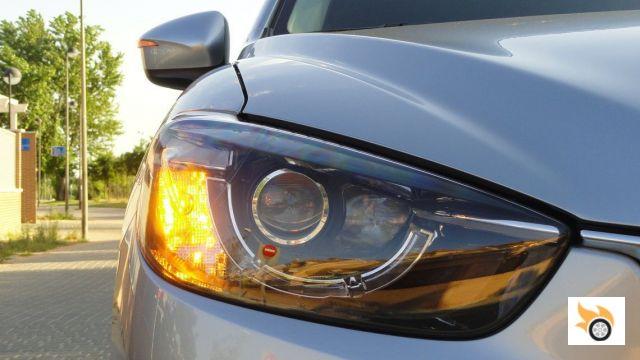
Once the quietness of the fast motorways is over, the new stretch is similar to the one I experienced when I left Mazda: straights interrupted by roundabouts, but with more speed and a lot of Christian around me. You drive the gearbox, which is smooth in all circumstances, and always fun. All goes well until I meet one of those drivers who thinks he lives alone. Not only does he drive badly, but he suddenly decides to go the opposite of what he has marked with his blinker. We're going fast. The collision course is set. I try to slow down without abruptness and again the roundabout-hamburger syndrome appears, but with the turn signal cucumber upside down. I eat them! The situation doesn't allow for any kind of rudeness, so I hit the brakes unceremoniously, with some ABS intervention. There's been no danger at any time, but it's been abrupt, and I don't like that. This is the second time I've had the same problem and it's not for lack of experience. I've driven heavier cars with much more horsepower. Before the third opportunity comes, I decide to try it without roundabout or traffic in a stretch that allows it. The brakes again - it's not me! The Mazda CX-5 brakes "long". The deceleration progression is not linear; too soft at the beginning, too abrupt at the end. A specific problem with this car? Maybe. It has not many kilometers, more than 13,000, but that, sometimes, is a world for a car that 40 hands go through. As I'm not going to get another one to test and the day has hours and kilometers left, I take note. On the one hand to brake to the taste of the car without suffering for it and on the other hand to point it out in the test as a "problem".
The first mountain pass arrives. There is a double lane for those of us going up. Without heavy traffic it doesn't go badly. The slow vehicles keep disciplined the right and the left lane is clear. If you don't mind the gear change suggestions, the revs rise just enough to negotiate the mountain pass with ease. Watch out for the speed limits! The machine pushes hard and you reach them in the blink of an eye. The feeling on this stretch is that you're driving a car with a high centre of gravity. The cavalry eats up the weight, and the slope moderates the inertia. The suspension controls the body roll without concessions. The gearbox, here, is reduced to four gears that go in and out without difficulty, admitting without problems reductions 4ª-2ª. No complaints. The Mazda CX-5 corners with docility and precision. You definitely forget it's an SUV. On unintentional - or voluntary - "stepping over" lane markers, another safety measure comes into play (LKA), and a gentle vibration in the steering wheel reminds you to stay in the middle.
The next two mountain passes are more or less the same, only with less and less traffic due to the characteristics of the chosen route. Driving is enjoyable. The Bose system is muted and now I listen to the chamber orchestra (combustion), for four cranks and a crankshaft. You have to be careful not to overreact and shoot the speedometer. I have to check the consumption that a family man would do with her inside. After succumbing to temptation just enough - sin, but don't have vices, said St. Augustine - I land in a long valley at about 1,100 meters of altitude. I can't believe it, 35ºC at 1 o'clock in the afternoon at that altitude. Long live CO2 emissions, global warming and the Americans and Australians, who didn't want to sign the Kyoto Protocol! Of course, with sin goes penance: Hurricane Katrina and the hole in the ozone layer. Forgive the slip, but if I don't say it, I'll burst.
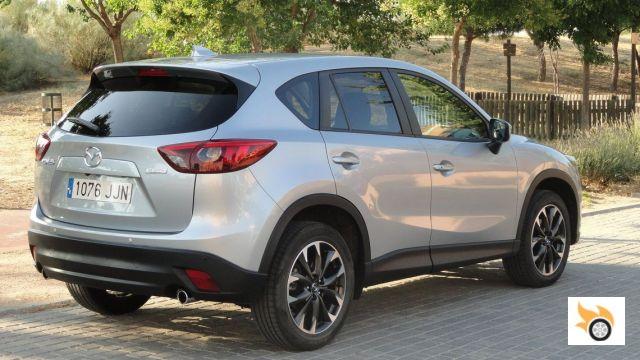
After the valley, another ascent to an altitude of over 1,500 metres. The temperature doesn't give truce. The Mazda doesn't make a sound. From that point to the destination, more or less at the same altitude, you have to go down a pass to climb the next one. Orography made in spain, what a marvel! On the descents, the lazy nature of the brakes is once again evident. I've got the hang of the system and I don't care. With some samba on the gear lever and braking in advance nothing happens.
We arrive at the destination, a huge pine forest that guarantees shade and the calm flow of the wind between the branches of the trees. We have to negotiate about three kilometres of dirt track. The hardness of the road-ready suspension and the 19-inch wheels, which faithfully translate the irregularities of the road, make it advisable to approach the stretch with calm. The CX-5 isn't made for this, and neither is any car. It only has the advantage of height, which translates into peace of mind in the knowledge that you're not going to leave your crankcase on a stone. The first photographs fall.
After the photo session I check the thermometer again: 31 ºC and obviously I'm in the shade. At that altitude and in that place I had never experienced anything like that. I then decide to put the seats through a complete stress test -which the CX-5 seats pass without any problems- consisting of a restorative nap. Yes, my friends, testing cars has these "risks and drawbacks".
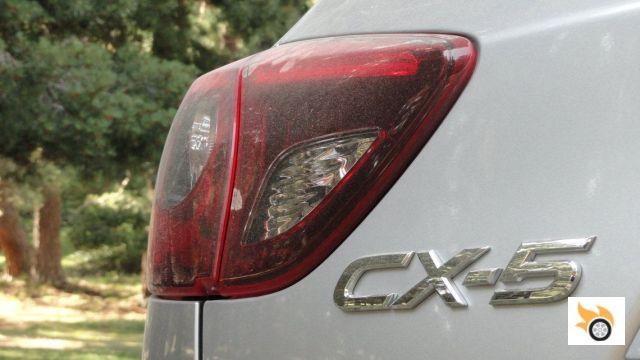
Knowing what's falling in the capital, while enjoying the peace offered by nature, I decide to stay there until the evening. I want to try the delights of the ALH and AFLS technology I mentioned above. The idea is to switch on the "auto" mode on the light control lever and not to touch it again on the way back, no matter what. The pine forests at dusk are full of magic. The powerful LED lights draw whimsical figures as you go along. From the memory of some childhood stories, you are not spared by any technology. Paura...
Finally on asphalt. When I meet the first vehicle in front of me, my instinct makes me lower the lights by hand. No! I have to let the automatism work. For the next one, I overcome the temptation and yes, the system changes quickly as soon as it detects an opponent. I'd already had the chance to check the reaction time when entering tunnels: the lights come on after one second, and if the light/dark transition is more progressive, it takes two. As I pass more vehicles and catch up with others, the more I trust the automatic light changeover system. It is curious to see how the anti-dazzle system works with the game of turning off a group of LEDs. The rear-view mirror is also enabled to prevent light attacks from those behind us. When the latter system is operating, a discreet green indicator light on the mirror indicates that it is working.
Back to the doors of the house. I check the on-board computer: about 380 km of trip with a fuel consumption of 4.7 litres/100 km. Very good data, because there has been a lot of uphill and downhill, air conditioning from start to finish and not in all the sections I have listened to the system's gear suggestion. There's a reason for everything. 5th and 6th gear are super-direct. In 6th gear, at 1,500 RPM, the CX-5 reaches 90 km/h and at 2,000 RPM, 120 km/h. The engine works very well in the 1,500-2,000 RPM range, which if not abandoned, whatever the gear ratio inserted, yields very low fuel consumption figures for a car of the CX-5's characteristics. Here, this Mazda can boast against pure passenger cars, lighter, which spend much more (like mine, without going any further).
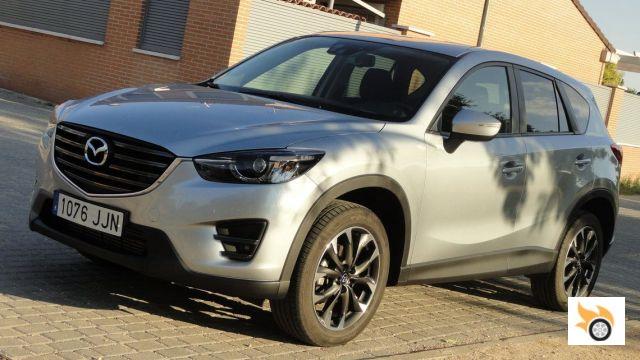
The rest of the test took place in urban traffic, light during the month of August, but with peaks of intensity at certain times. In this scenario, Mazda's i-stop system came into play with intensity. It's true that it works very quickly at start-up, but sometimes it's a drawback. On the one hand, and I put it down to the need to meet the target temperature of the climate control, it was activated in stops of more than a minute (although not always) without the time to do it. On the other hand, with very fluid traffic between traffic lights, it leaves the car stuck at the exit and if you don't spin fine, you can even stall the engine. It can be deactivated, obviously, and perhaps it is more advisable in times of "real" traffic jams. In the same scenario, the staggered shifting between 1st and 4th gear forces you to play with the lever continuously. If the stretch to be covered in the city is long, you miss the automatic gearbox. If we add to all this the lack of immediacy of brake response and the continuous alerts from the safety systems (motorcyclists appear like mushrooms in autumn), what was designed to facilitate traffic becomes a source of stress. This invites us to reflect on what to wear depending on the circumstances. Of course, the way of driving in the city increases consumption significantly, but again the Mazda CX-5 surprises compared to other vehicles. After 740 km of use, in the terms that I have told you, at an average speed of 48 km / h, 5.6 l/100 km seems to me a low consumption for the characteristics and performance of the car (a "1600" tourism of the previous decade, spends more rolling only on the road).
Conclusions
I have to say that I don't love the SUV concept. The versatility leads to products that do not stand out in anything and are mediocre in everything. The best is the enemy of the good, they say. But my personal preferences are irrelevant for the purposes of the test. Like it or not, crossover and SUV concepts are here to stay for a good season. It's what the consumer demands or what manufacturers have induced in their taste, depending on how you look at it. The fact is that they are in circulation by the thousands. Under this consideration and seen in the context of its peers, the Mazda CX-5 of the test is a car that has made a pleasant impression. It drives well, allows overtaking with forcefulness, it is comfortable and spacious, it spends little and the aesthetics is pleasant. I think it has enough arguments to shine with its own light. I don't like SUVs, it's true, but I wouldn't mind driving this one again. Maybe with another engine, maybe also for Pistonudos... Who knows.

























